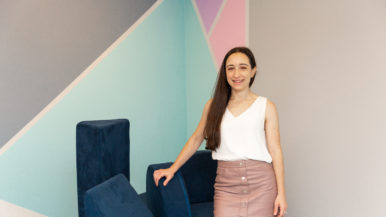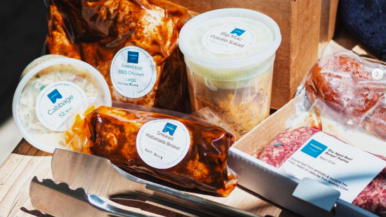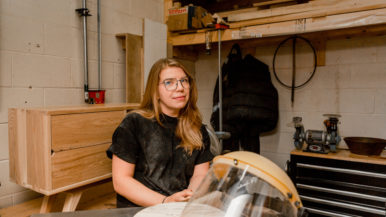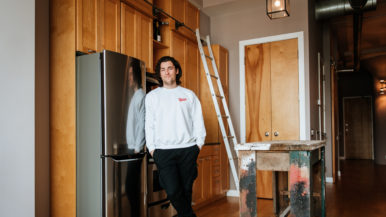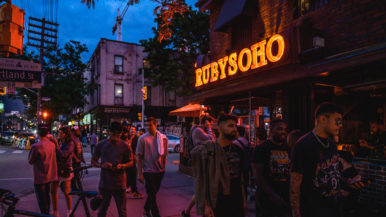“We want to make sure these people are protected”: An Ontario sewing group is creating thousands of masks for front-line workers

I learned how to sew in high school, and it’s been a hobby of mine ever since. By day, I run a paralegal firm. By night, I sew sleep sacks, onesies and bibs for my seven-month-old daughter. Last week, my husband saw an article on Make magazine’s website about how to sew fabric masks during the pandemic. I made a few for our family and posted pictures on Facebook. Soon, I was getting messages from nurses and health care workers—first from people I knew, then from people I didn’t—asking if I could sew masks for them, too. Within a couple of days, I had too many requests to handle on my own. On Monday, I started a Facebook group called Durham Region Sews, to get some seamstresses in the Durham region to help out. The group grew to 300 people in a single day. We started out with requests for 120 masks. By Wednesday, we’d received requests for 2,179. They’re mostly coming from nurses and other front-line workers who need more protection.
It’s terrifying that these requests are coming in at all, because it means we’re running out of personal protective equipment. We’re making what we call “masks of last resort.” They’re sewn from tightly woven fabrics like cotton or poly-cotton blend, and they’re not meant to be used in place of PPE. They’re not intended to replace social distancing, or to lull people into a false sense of security that they can give one to their grandmother and still visit her. These masks won’t filter out the virus, but they will add a layer of defence against airborne droplets and particles. We just want to make sure our nurses and front-line workers are protected.
When we had about 150 sewers willing to help, I reached out to three members who run businesses or sit on boards in our community. Each of them is overseeing a different part of the operation: Rebecca Boyd is managing the sewing teams and logging completed masks. Teresa Shaver is supervising patterns and designs to make sure the sewers stay as consistent as possible. And Jennifer Humphries is co-ordinating the collection, sterilization and distribution of donated material, plus doing all the cleaning and packaging of finished masks.
We might not be able to fill each order, but we’re trying our best. We have about 400 people sewing for us across the province, and we’re up to 2,625 requests and counting. We’re sewing scrub caps, too, because doctors have requested them. We’ve received requests from nurses and personal support workers across the province who don’t have adequate protection. We’ve had people working at retirement homes reach out, asking for masks for their residents. We also heard from a foster-care centre, to help protect their staff who are in and out of homes all day. I’m surprised I haven’t heard from grocery store employees yet.
Canada doesn’t have a recommended mask pattern, so we’re using patterns from hospitals in the U.S. If they meet their standards, I’m hoping they’ll meet our standards, too. The hospitals here don’t want to use the masks we’re making—they still have enough of their own right now, and these ones aren’t medical-grade. If we end up with extra, we’re going to send them to American hospitals that are requesting them, like Deaconess Hospital in Washington. Fabric stores aren’t considered an essential service, so we can’t get new material. We spent the first two days collecting bolts of fabric from stores and people and delivering them to sewers who want to help. Durham region is still the epicentre of the operation, but we now have people as far as Ottawa and Windsor sewing for us. We renamed the group Ontario Sews to reflect that.
Our first deliveries went out Tuesday to a cancer centre and a nursing home, and to fill a private request from a nurse. UPS is letting us use their drop-off centres for donations and sewn masks; we’re providing masks for any of the drivers for any UPS location that works with us. As our seamstresses finish their masks, they drop them at the UPS location closest to their homes. The masks get delivered to us, and we sort them based on type (with or without pockets for filters) and where they’re headed, and label them to let prospective wearers know they’re not medical-grade protection. We’ve delivered more than 100 masks so far, and now that our delivery system is up and running, that number will rise every day.
I usually sew in the office in the basement of my home in Oshawa. I’ve taken it over now, there’s just fabric everywhere. The fabric store on our street had to close its doors this week, so the owners gave us a 75 per cent discount on the stock they had left. I’m going to disperse the spools that I have to other sewers. I haven’t made any masks since the first ones I made for my family; it feels like I’ve been on the phone for the last three days straight organizing volunteers and getting UPS on board. Depending on their levels of experience and schedules, some of our sewers can make up to 50 masks in a day. I got a call yesterday morning from a woman who had 60 masks to drop off.
The equipment shortage is a worldwide crisis. I know our government has said they’ve placed orders for more masks and they’re on their way. I just hope that they’re going to get here in time. I get overwhelmed, sometimes, by everything that’s happening in the world right now. My husband tells me I’m a competitive person, and I think this is my way of fighting back. It’s my way of saying, “We’re not going to take this sitting down.”
